Complete Solutions to EXERCISES of chapter PHOTOELECTRIC EFFECT of Class 12 book with complete answers and questions
| Class 12 | PHYSICS |
| Chapter | PHOTOELECTRIC EFFECT |
| CP SINGH | EXERCISES |
| Number Of Questions | 73 |
| Academic Year | 2023-24 |
Which of the following is correct regarding photons?
(i) A photon always travels at a speed `3xx10^(8)m//sec` in vacuum.
(ii) The rest mass of photon is zero.
(iii) Let E and p be the energy and linear momentum of a photon and v and `lambda` be the frequency and wavelength of the same light when it behaves as a wave. Then `E=h v =(hc)/(lambda)`
`p=(h v)/(c) =(h)/(lambda) =(E)/(c)`
(iv) A photon may collide with a meterial particle. The total energy and the total momentum remain conserved in such a collision. The photon may get absorbed and / or a new photon may be emitted. Thus, the number of photons may not be consverved.04:28View SolutionThe equation E=pc is valid
01:55View SolutionLet p and E denote the linear momentum and energy of a photon. If the wavelength is decreased,
01:03View SolutionThe energy of a photon in eV of wavelength `lambda` nm will be
02:25View SolutionIf 5% of the energy supplied to a bulb is irradiated as visible light, how many quanta are emitted per second by a 100 W lamp? Assume wavelength of visible light as `5.6xx10^(-5)` cm.
01:58View SolutionA hydrogen atom moving at a speed v absorbs a photon of wavelength 122 nm and stops. The value of v is (mass of hydrogen atom `=1.67xx10^(-27)` kg)
02:17View SolutionLet `(n_r) and (n_b) be respectively the number of photons emitted by a red bulb and a blue blub of equal power in a given time.
05:12View SolutionA beam of white light is incident normally on a plane surface absorbing `70%` of the light and reflecting the rest. If the incident beam carries 20 W of power, the force exerted by it on the surface is
04:02View SolutionWhich of the following is correct regarding photo-electric effect?
(i) The photo-electric effect takes place if `lambda le lambda_(0)` or `upsilon ge upsilon_(0)`. maximum K.E. of photo-electron `K_(max) =hv=(hc)/(lambda)`
Einstein photo-electric effect equation `hv=hv_(0) + K_(max)`
(ii) The maximum K.E. of electron or stopping potential `V_(s)(K_(max) =eV_(s))` for a given metal depends only on frequency or wavelength of incident light and not on its intensity
(iii) The saturation current (i =ne, n: number of photo-electrons ejected per unit time) depends on intensity and not frequency
(iv) Normally it is assumed that one photon eject one electron. Practically several incident photons eject one electron. If quantum efficiency is given
`{"Quantum efficiency" =("Number of electrons ejected")/("Number of photons incident")}`
Number of electrons ejected must be calculated must be calculated and then calculate saturation current03:33View SolutionWhich of the following is correct regarding Einstein photo-electric effect equation?
(i) The equation is `hv =hv_(0) + K_(max) =hv_(0)+ eV_(s)`
(ii) The variation of `V_(s)` with v is
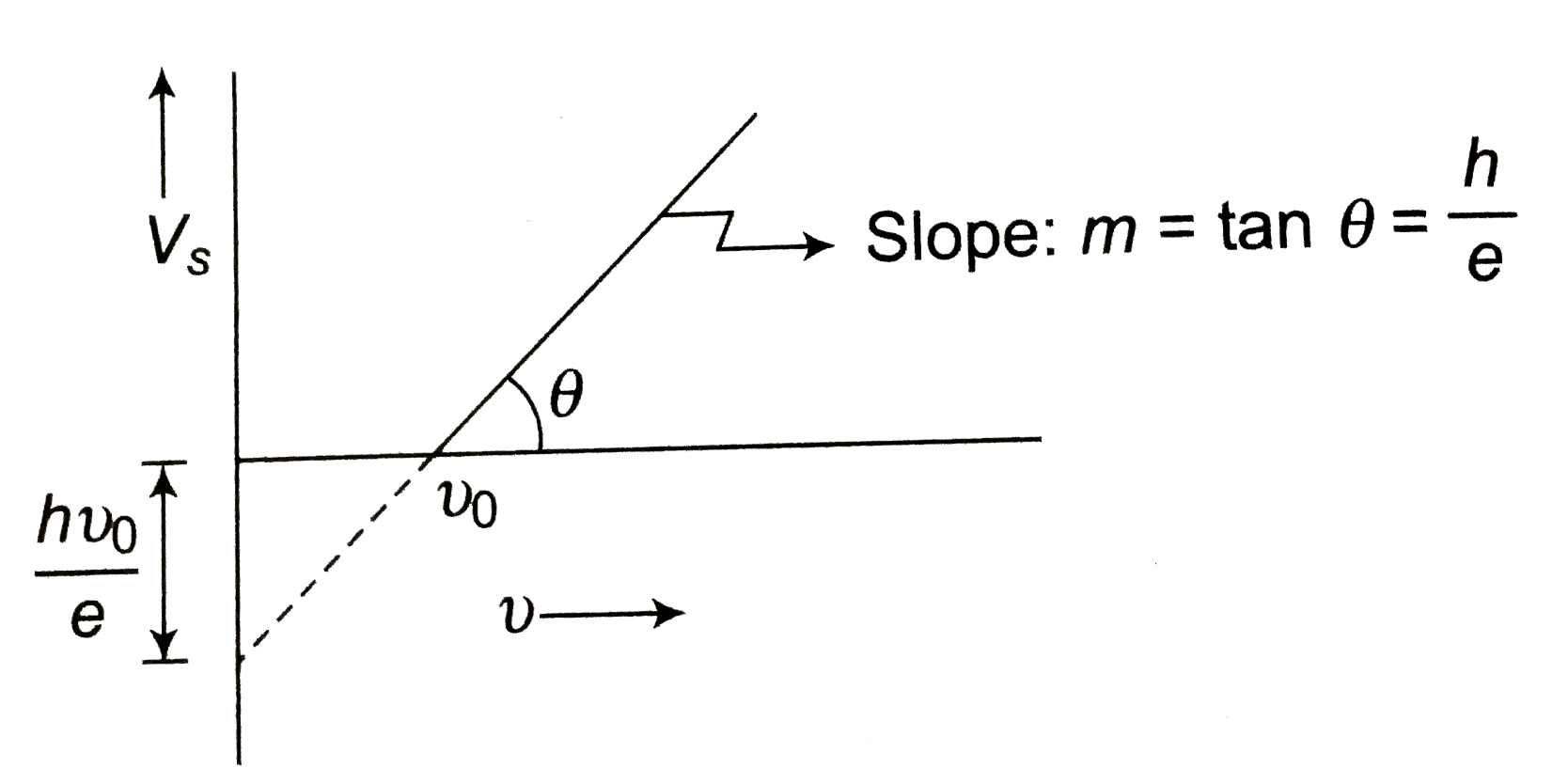
(iii) The variation of photo-current versus applied potential

(iv)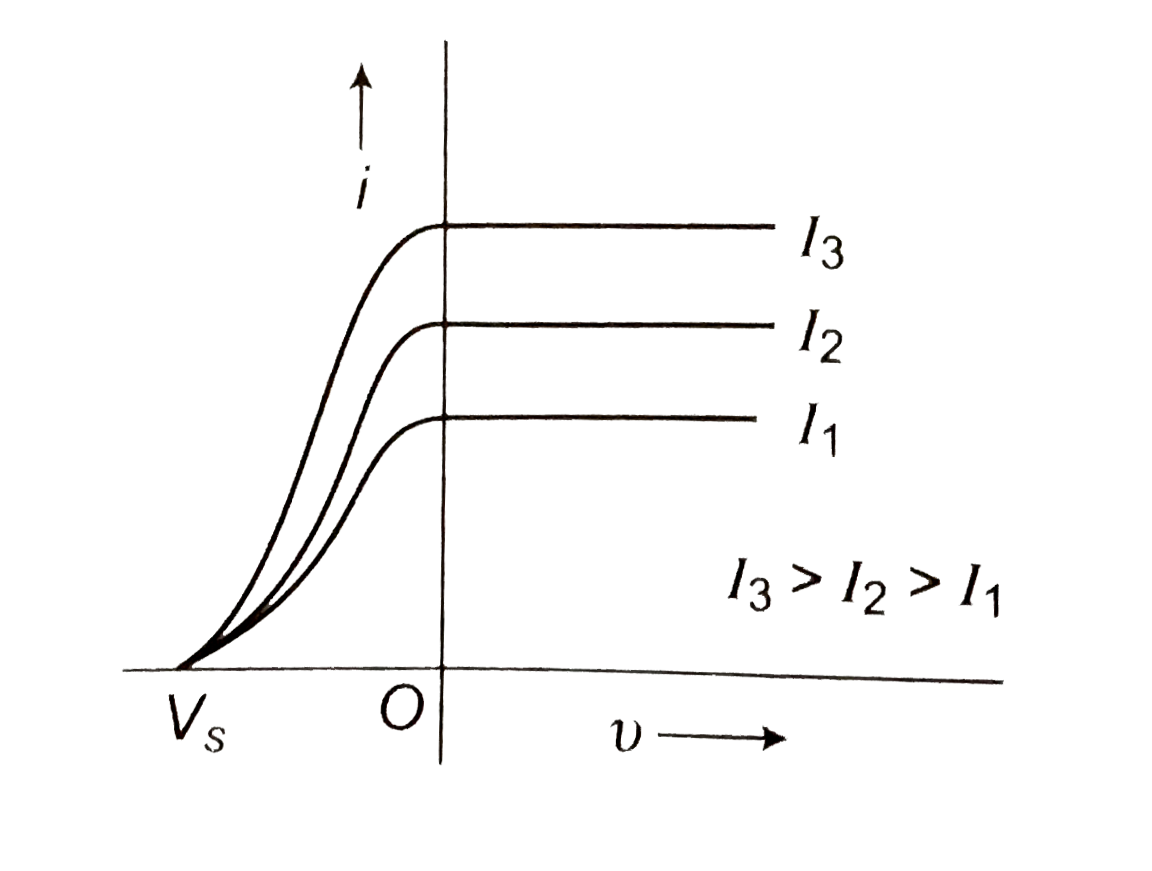
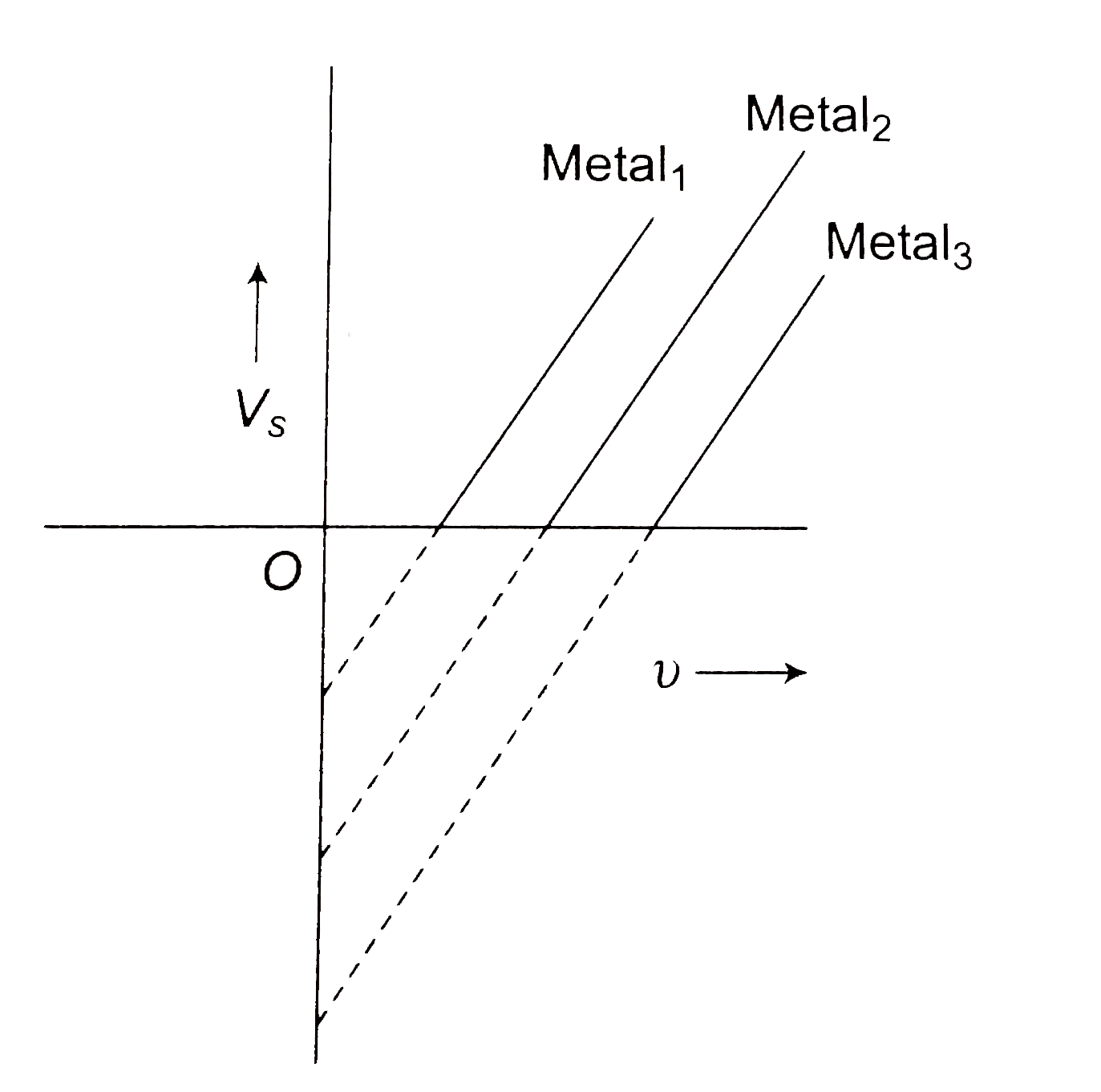 05:57View Solution
05:57View SolutionAs the intensity of incident light increases
02:24View SolutionThe number of photo - electrons emitted per second from a metal surface increases when
02:57View SolutionPhotons of frequency v fall on a metal surface for which the thershold frequency is `v_(0)(vge v_(0))`. Then,
03:28View SolutionWhich of the following statements about photoelectric effict is/are false ?
(i) It exhibits the particle nature
(ii) Electrons are emitted only if the radiation has a frequency above a certain value
(iii) All the electrons emitted by radiation of a particular frequency have the same energy
(iv) Changing the intensity of radiation changes the maximum energy with which the electrons can be emitted03:29View SolutionWhen stopping potential is applied in an experiment on photoelectric effect, no photo current is observed. This means that
02:48View SolutionIn photoelectric effect
04:18View SolutionA metallic surface ejects electrons when exposed to green light of intensity I but not when exposed to yellow light of intensity I. It is possible to eject electrons from the same surface by
(i) yellow light of some intensity which is more than I
(ii) green light of any intensity
(iii) red light of any intensity
(iv) violet light of any intensity04:51View SolutionLights of two different frequencies whose photons have energies 1 and 2.5 eV, respectively, successively illuminate a metal whose work function is 0.5 eV. The ratio of the maximum speeds of the emitted electrons
01:38View SolutionTwo identical photocathodes receive light of frequency `f_(1) andf_(2)` if the velocites of the photo electrons (of mass `m`) coming out are repectively `v_(1) and v_(2)` then
01:46View SolutionRadiation of wavelength `lambda` in indent on a photocell . The fastest emitted electron has speed `v` if the wavelength is changed to `(3 lambda)/(4)` , then speed of the fastest emitted electron will be
03:19View SolutionWhen a certain metallic surface is illuminated with monochromatic light of wavelength `lamda`, the stopping potential for photoelectric current is `3V_0` and when the same surface is illuminated with light of wavelength `2lamda`, the stopping potential is `V_0`. The threshold wavelength of this surface for photoelectrice effect is
02:54View SolutionPhotoelectric emission is observed from a metallic surface for frequencies `v_(1)` and `v_(2)` of the incident light rays `(v_(1) gt v_(2))`. If the maximum values of kinetic energy of the photoelectrons emitted in the two cases are in the ratio of `1 : k` , then the threshold frequency of the metallic surface is
01:57View SolutionA photon of wavelength `1000 Å` has energy `12.3 eV`. If light of wavelength `5000 Å`, having intensity I, falls on a metal surface, the saturaion current is `0.40 mu A` and the stopping potential is `1.36 V`. The work function of metal is
02:25View SolutionIn the previous, if the intensity of light is made 4 I, the stopping potential will become
02:20View SolutionIn question 23, if the intensity of light is made 4 I, the saturation current will become
02:20View SolutionThe threshold frequency for certain metal is `v_0`. When light of frequency `2v_0` is incident on it, the maximum velocity of photoelectrons is `4xx10^(6) ms^(-1)`. If the frequency of incident radiation is increaed to `5v_0`, then the maximum velocity of photoelectrons will be
02:41View SolutionIn an experiment on photoelectric effect light of wavelength `400 nm` is incident on a metal plate at rate of `5W.` The potential of the collector plate is made sufficiently positive with respect to emitter so that the current reaches the saturation value. Assuming that on the average one out of every `10^6` photons is able to eject a photoelectron, find the photocurrent in the circuit.
04:29View SolutionIf Planck's constant is denoted by h and the charge by e, experiments on photoelectric effect allow the determination of
02:01View SolutionIn order to increase the kinetic energy of ejected photoelectrons, there should be an increase in
02:22View SolutionIn photoelectric emission the number of electrons ejected per second is proportional to the
02:16View SolutionWhen monochromatic radiation of intensity I falls on a metal surface, the number of photoelectrons and their maximum kinetic are N and T respectively. If the intensity of radiation is 2 I, the number of emitted electrons and their maximum kinetic energy are respectively.
02:36View SolutionLight of frequeny 1.5 times the threshold frequency , imcident on a photo sensitive material .If the frequency of incident light is halved and the intensity is doubled the photo current becomes
03:14View SolutionIf the wavelength of light in an experiment on photoelectric effect is doubled,
(i) the photoelectric emission will not take place
(ii) the photoelectric emission may or may not take place
(iii) the stopping potential will increase
(iv) the stopping potential will decrease03:40View SolutionWhen ultraviolet radiation is incident on a surface, no photoelectrons are emitted. If another beam causes photoelectrons to be emitted from the surface, it may consist of
(i) radio waves
(ii) infrared rays
(iii) X-rays
(iv) gamma rays02:07View SolutionA non-monochromatic light is used in an experiment on photoelectric effect. The stopping potential
04:23View SolutionWhen the intensity of a light source is increased
02:33View SolutionThe photocurrent in an experiment on photoelectric effect increases if
03:15View SolutionA point source of light is used in a photoelectric effect. If the source is removed farther from the emitted metal, the stopping potential
02:31View SolutionA phot of energy `h upsilon` is absorbed by a free electron of a metal having work function `phi lt h upsilon`
03:29View SolutionPhotoelectric effect supports quantum nature of light because
(a) there is a minimum frequency of light below which no photo electrons are emitted
(b) the maximum kinetic energy of photo electrons depends only on the frequency of light and not on its intensity
(c ) even when the metal surface is faintly illuminated, the photo electrons leave the surface immediately
(d) electric charge of the photo electrons is quantised01:32View SolutionIf the frequency of light in a photoelectric experiment is doubled the stopping potential will
03:41View SolutionTwo identical metal plates show photoelectric effect by a light of wavelength `lambda_(A)` falls on plate `A` and `lambda_(B)` on plate `B(lambda_(A) = 2 lambda_(B))`. The maximum kinetic energy is
03:00View SolutionThe cathode of a photoelectric cell is changed such that the work function changes from `(W_(1) to W_(2) (W_(2) gt W_(1))`. If the current before and after change are `I_(1)` and `I_(2)`, all other conditions remaining unchanged , then (assuming `hv gt W_(2)`)
02:29View SolutionThe frequency and intensity of a light source are both doubled. Consider the following statements
A. The saturation photocurrent remains almost the same
B. The maximum kinetic energy of the photoelectrons is double04:00View SolutionThe threshold wavelength for photoelectric emission from a
material is `5200 Å`. Photoelectrons will be emitted when this material is
illuminated with monochromatic radiation from a
(a) 50 W infrared lamp
(b) 1 W infrared lamp
(c ) 50 W ultraviolet lamp
(d) 1 W ultraviolet lamp
.03:03View SolutionA photoelectric cell is illuminated by a point source of light `1 m` away . When the source is shifted to `2 m` then
02:08View SolutionIf the distance of 100 Watt lamp is increased from a photocell, the saturation current i in the photo cell varies with distance d as
02:01View Solution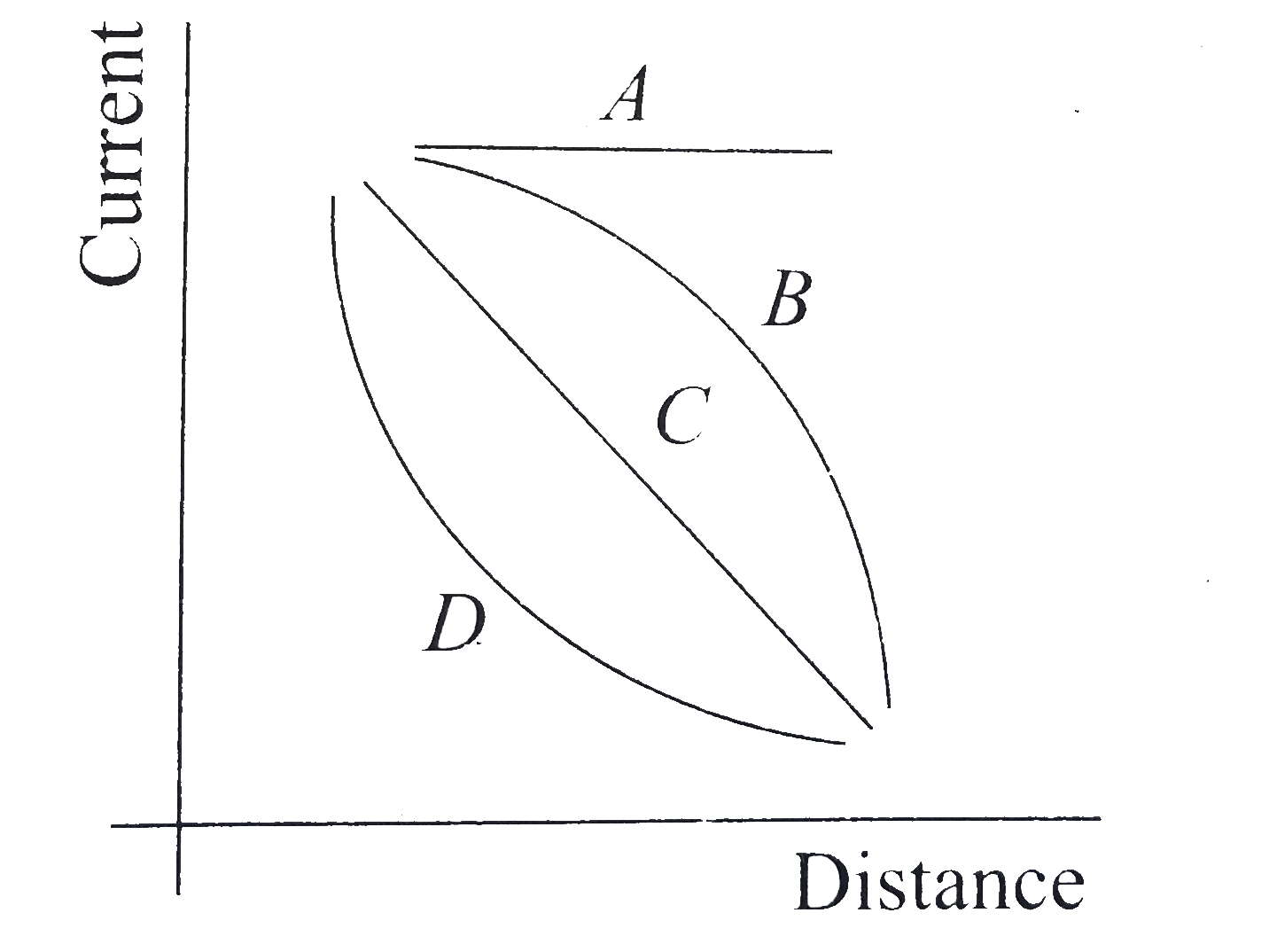
A point source causes photoelectric effect from a small metal plate. Which of the curves in Fig. may represent the saturation photo-current as a function of the distance between the source and the metal?01:50View SolutionWhen a monochromatic point source of light is at a distance
of 0.2 m from a photoelectric cell, the cut off voltage and the saturation current
are respectively 0.6 V and 18.0 mA. If the same source is placed 0.6 m away
from the photoelectric cell, then
(a) the stopping potential will be 0.2 V
(b) the stopping potential will be 0.6 V
(c ) the saturation current will be 6.0 mA
(d) the saturation current will be 2.0 mA02:15View SolutionThe collector plate in an experiment on photoelectric effect is kept vertically above the emitter plate . Light source is put on and a saturation photo current is recorded . An electric field is switched on which has a vertically downward direction . Then
 01:24View Solution
01:24View SolutionThe electric field associated with a light wave is given by `E= E_0 sin [(1.57 xx 10^7 m^(-1)(x-ct)].` Find the stopping potential when this light is used in an experiment on photoelectric affect with a metal having work - function 1.9 eV.
02:53View SolutionA beam of light of wavelength `lambda` is incident on a metal having work function `phi` and placed on a metal having work function `phi` and placed in a magnetic field B. The most energetic electrons emitted perpendicular to the field are bent in circular arcs of radius R. Then
02:43View SolutionA photon of energy E ejects a photoelectron from a metel surface whose work function is `phi_(0)`. If this electron enters into a unifrom magnetic field of induction B in a direction perpendicular to the field and describes a circular path of radius r, then the radius r, is given by, (in the usual notation)
03:44View SolutionA monochromatic light of wavelength `lambda` is incident on an isolated metallic sphere of radius `a`. The threshold wavelength is `lambda_(0)` which is larger then `lambda`. Find the number of photoelectrons emitted before the emission of photo electrons stops.
03:25View SolutionPhotoelectric effect experiments are performed using three different metal plates `p,q` and`r` having work function `phi_(p) = 2.0 eV, phi_(e) = 2.5 eV and phi_(r) = 3.0 eV` respectively A light beam containing wavelength of `550nm , 450 nm` and `350nm ` with equal intensities illuminates each of the plates . The correct `I -V` graph for the experiment is [Take hc = 1240 eV nm]
07:59View SolutionThe graph between `1//lambda` and stopping potential (V) of three metals having work- functions `Phi_1`, `Phi_2` and `Phi_3` in an experiment of photoelectric effect is plotted as shown in the figure. Which of the following statement(s) is/are correct? (Here, `lambda` is the wavelength of the incident ray). (a) Ratio of work functions `phi_1 : phi_2 : phi_3 = 1 : 2 : 4` (b) Ratio of work functions `phi_1 : phi_2 : phi_3 = 4 : 2 : 1` (c ) tan `theta` is directly proportional to hc / e, where h is Planck constant and c is the speed of light (d) The violet colour light can eject photoelectrons from metals 2 and 3 .
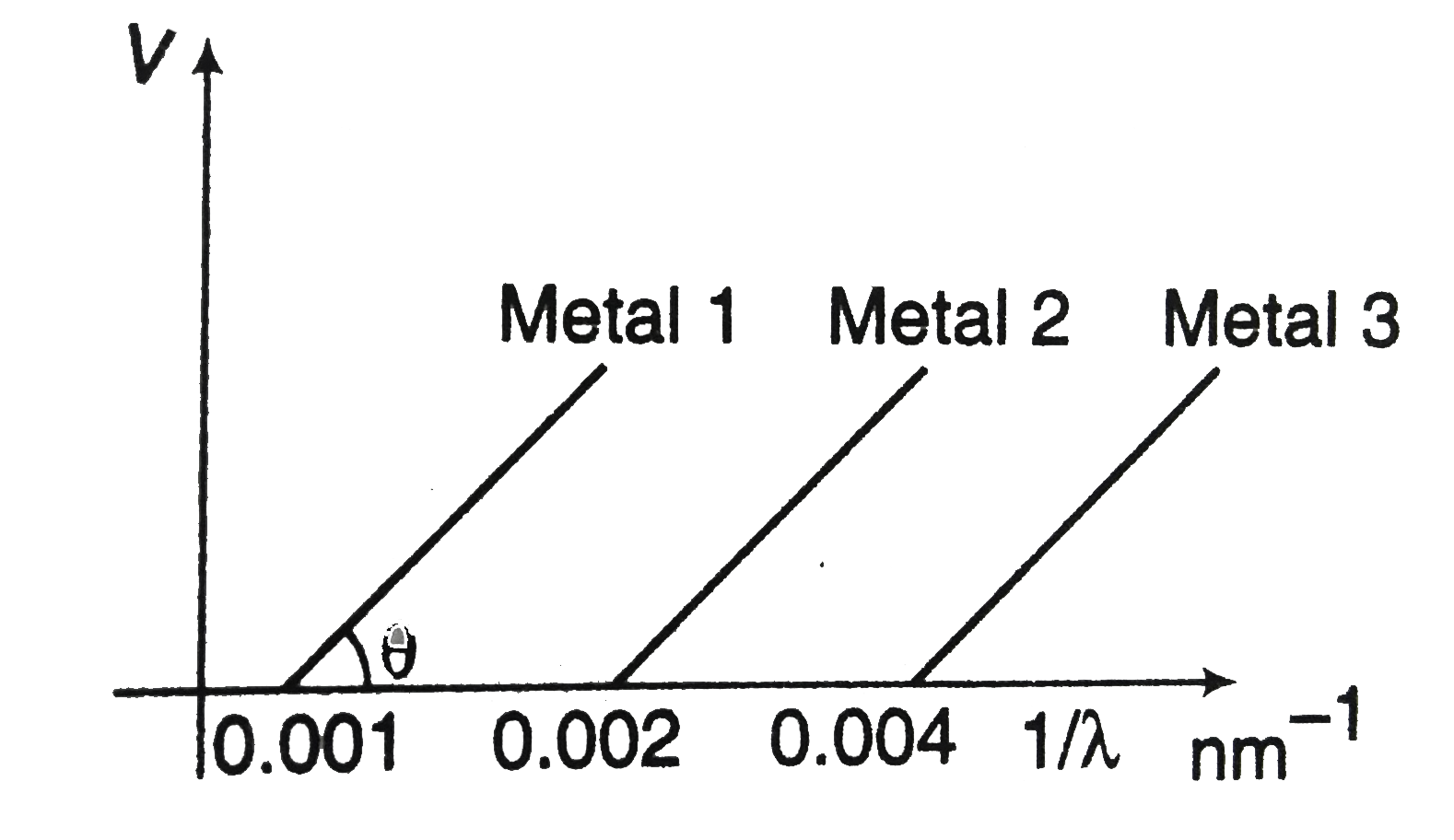 03:43View Solution
03:43View SolutionThe figure shows a plot of photo current versus anode potential for a photosensitive surface for three different radiations. Which one of the following is a correct statement ?
 03:20View Solution
03:20View SolutionWhich of the following is correct regarding de-Broglie wavelength?
02:09View Solutionde-Broglie wavelength associated with an electron accelerated through a potential difference V is `lambda`. What will be its wavelength when the accelerating potential is increased to 4V?
04:37View SolutionAn electron of mass `m_e` and a proton of mass `m_p` are accelerated through the same potential difference. The ratio of the de Broglie wavelength associated with an electron to that associated with proton is
02:28View SolutionA proton and an electron are accelerated by the same potential difference, let `lambda_(e)` and `lambda_(p)` denote the de-Broglie wavelengths of the electron and the proton respectively
01:59View SolutionIn which of the following cases the heavier of the two particles has a smaller de-Broglie wavelength ? The two particles
02:02View SolutionIf the kinetic energy of the particle is increased to `16` times its previous value , the percentage change in the de - Broglie wavelength of the particle is
01:57View SolutionThe de - Broglie wavelength of a neutron at `27 ^(@) C` is `lambda`. What will be its wavelength at `927^(@) C`?
02:02View Solution`lambda_(e),lambda_(p)` and `lambda_(alpha)` are the de-Broglie wavelength of electron, proton and `alpha` particle. If all the accelerated by same potential, then
03:27View SolutionWhen the mkomentum of a proton is changed by an amount `p_(0)`, the corresponding change in the de-Broglie wavelength is found to be `0.25%`. Then, the original momentum of the proton was
03:32View SolutionIf an electron and a photon propagate in the form of waves having the same wavelength , it implies that they have the same
01:02View SolutionWhat are matter waves? Show that de-Broglie wavelength associated with an electron of energy, V-electron volt is approx. `12.27/(sqrtV) Å`.
06:05View SolutionThe time required in emitting photoelectrons is
01:27View SolutionIn the Davisson and Germer experiment , the velocity of electrons emitted from the electron gun can be increased by
01:57View SolutionWhen the energy of the incident radiation is increased by `20 %` , kinetic energy of the photoelectrons emitted from a metal surface increased from `0.5 eV to 0.8 eV`. The work function of the metal is
02:59View SolutionLight with an enargy flux of `25xx10^(4) Wm^(-2)` falls on a perfectly reflecting surface at normal incidence. If the surface area is `15 cm^(2)`, the average force exerted on the surface is
03:34View SolutionIf the kinetic energy of the particle is increased to `16` times its previous value , the percentage change in the de - Broglie wavelength of the particle is
01:57View Solution
EXERCISES questions and complete solutions for chapter PHOTOELECTRIC EFFECT of CP SINGH PHYSICS (HINGLISH) of Class 12
